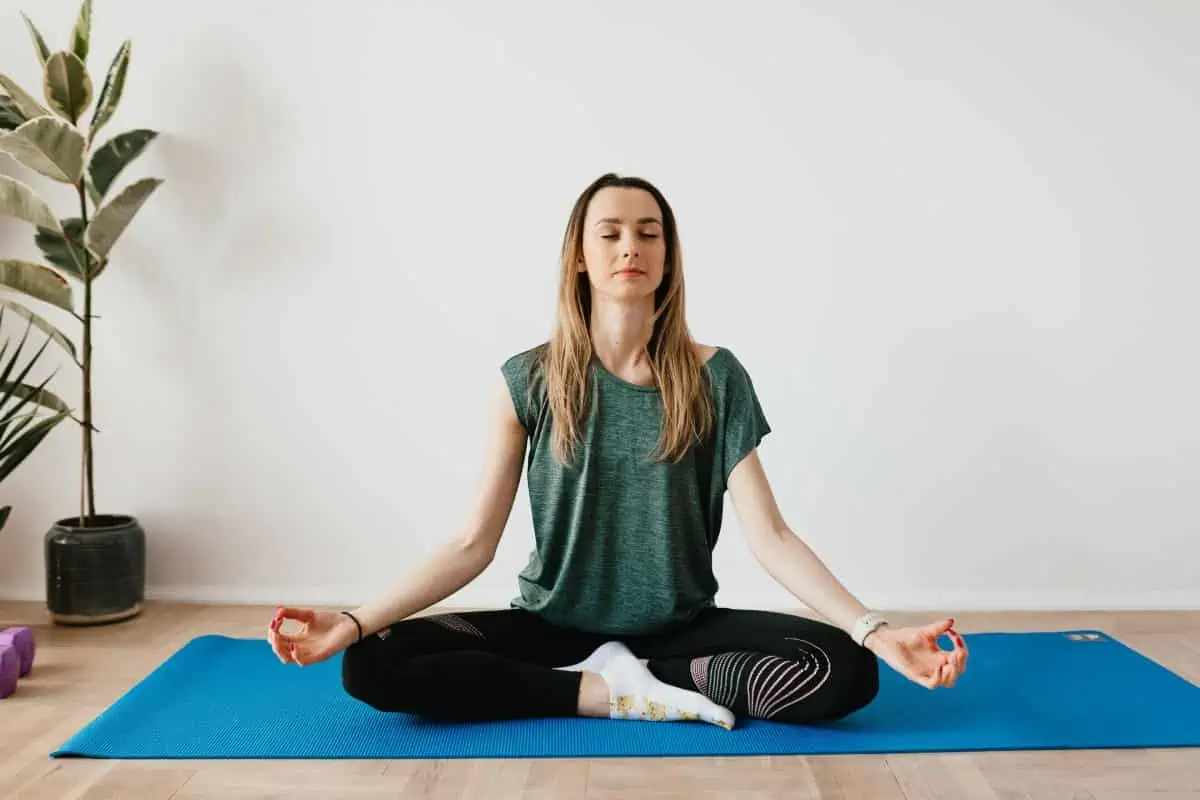Key Takeaway
Embrace the restorative power of gentle yoga to calm your mind, release muscle tension, and rejuvenate your body, regardless of your experience level.
Right now is the time to leave behind the notion of needing to push your body to its limits and instead embrace the beauty of a slow and gentle yoga practice. If you have been feeling burnt out, are on the edge of sustaining an injury, or are looking to give your brain a mental rest, gentle yoga is the choice for you.
Gentle yoga is an important accompaniment to intense fitness classes or a strong yoga workout. Sometimes, rest is best, and by following a gentle yoga sequence you are giving your body a chance to recuperate from the stress of daily life. Just one simple yoga session has the ability to calm your mind, release tension in your muscles, and reset your nervous system.
Plus, gentle yoga is not just for beginners. It is recommended that all yogis take some time to incorporate a gentle session into their weekly routine to allow for muscle recovery and mental relaxation.
So after your Iyengar yoga with chairs or your hot and sweaty vinyasa, don’t forget to make time for a gentle yoga session too. Here are some poses for you to try:
Contents
- 1 How to create your gentle yoga practice
- 2 Start with your breath
- 3 Child’s Pose (Balasana)
- 4 Downward-Facing Dog (Adho Mukha Svanasana)
- 5 Bound Angle Pose (Baddha Konasana)
- 6 Forward Bend Pose (Paschimottanasana)
- 7 Half Lord of the Fishes Pose (Ardha Matsyendrasana)
- 8 Corpse Pose (Savasana)
- 9 Finish with a short meditation practice
- 10 Putting it all together
- 11 Frequently Asked Questions:
How to create your gentle yoga practice
To create a home yoga practice, you must first set the scene for a relaxing time.
Light a candle, burn your favorite incense, or set up your diffuser with a relaxing scent. Get into your comfy yoga clothes and roll out your yoga mat. Try to limit your technological distractions by putting your favorite yoga playlist on and then switching your phone to airplane mode. Devoting 20 to 30 minutes to simply being with yourself is a wonderful gift. You deserve this time.
When you are ready to create your home yoga practice, choose around six yoga poses (there are six great options in the list below!) to move through intentionally. Breathe deeply, move slowly, and enjoy the benefits of restorative yoga poses for your mind and body.
Remember, you are your own greatest yoga instructor, for when you learn to listen to the language of your own body, you will know yourself better than anyone else in this world. Make your home the coziest of all yoga studios, and enjoy the benefits of relaxing in your own space.
Start with your breath
Breathing exercises can set you up for a beautiful and soft practice. Breathing is the most gentle way to switch your body from the sympathetic to the parasympathetic nervous system. This means turning off the stressful fight-or-flight mode and tuning into a state of deep rest and rejuvenation.
Simply reach your hands to the sky as you take a deep inhale and exhale to let the heaviness of your arms drop to your sides. Repeat this a few times. With every exhale, you can let go of stress and tension in your shoulders, soften your muscles, and feel your entire body arriving here in the present moment.

After releasing some tension from deep exhales, you can try a more controlled breathing exercise. One great technique to start your practice with is called alternate nostril breathing. This technique, known as Nadi Shodani, involves using the right hand to control the flow of air in and out of your nostrils. The left hand can rest on your left knee and take your right hand to your face. Your right thumb rests against the right nostril, and your ring finger (fourth finger) rests above the left nostril. You will use each finger to open and close the nostril to let the air flow in.
Start breathing in through the left nostril and out through the right. In through the right nostril and out through the left. This is one round. Repeat this at least 10 times to clear the mind, balance the body, and prepare for the yoga poses that will follow.
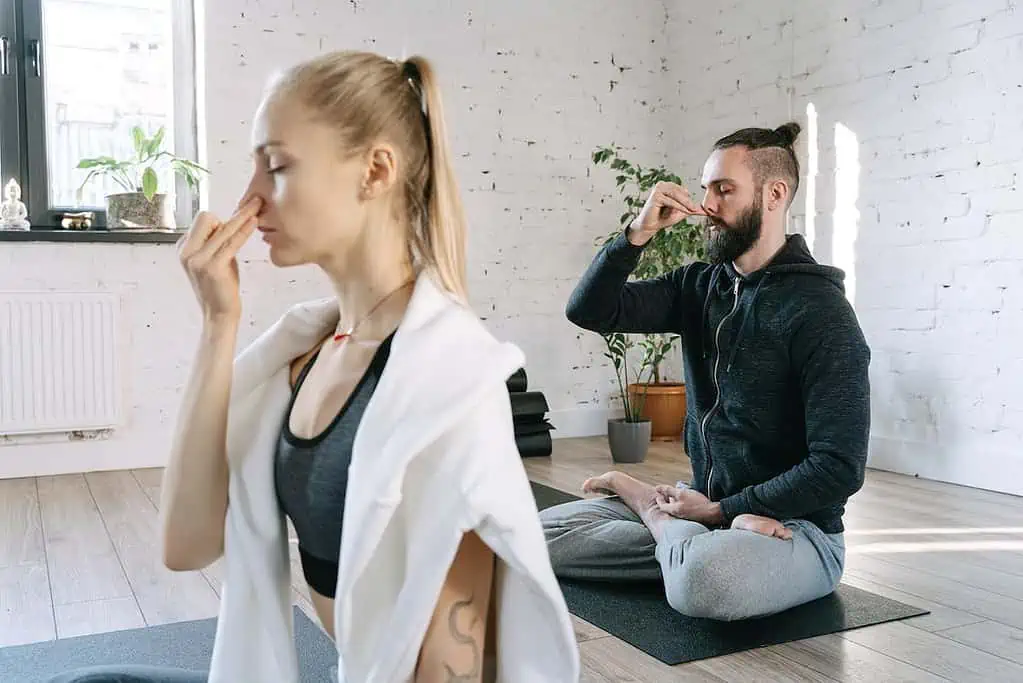
Child’s Pose (Balasana)
Child’s pose is one of the most basic yoga poses to add to a home yoga sequence. It is a whole-body stretch that feels wonderful for the shoulders and spine. Start by sitting back with your hips on your heels, and spread your knees to the edges of your mat while keeping your big toes together. Extend your spine straight to the sky, and then walk your hands out in front of you. Connect your forehead to the floor or mat beneath you. Take a deep breath in and let it out. Allow your physical body to soften into this pose as you hold it for a few moments.
This beginner yoga pose is great for opening up the hips and creating space in the spine. It can neutralize the body after a long day at work, or if you are practicing in the morning, it will set you up for a gentle day ahead!
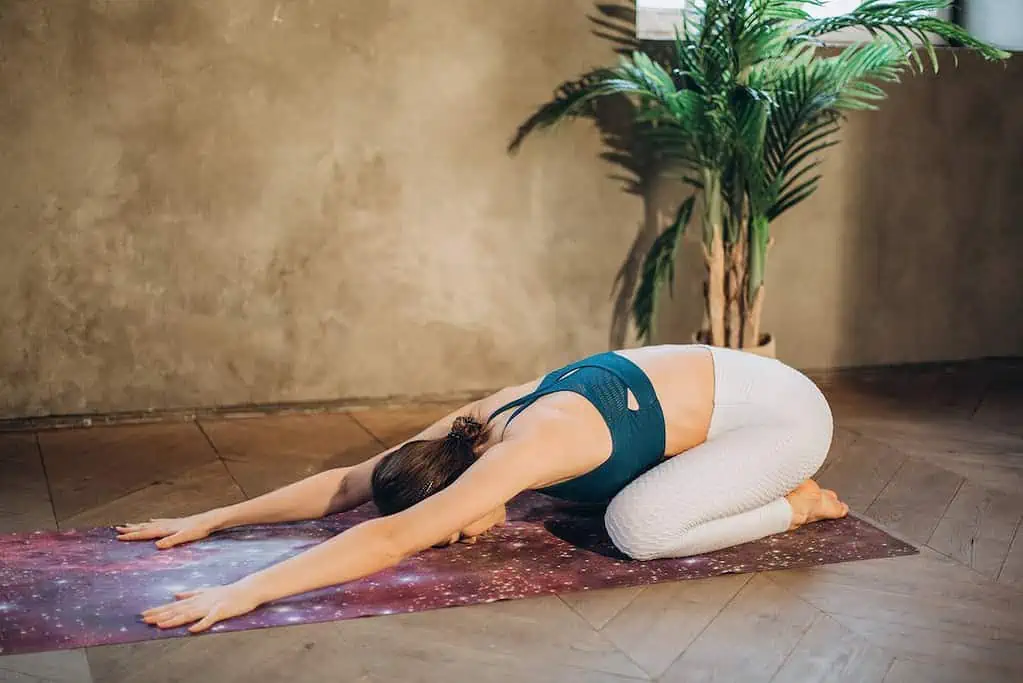
Downward-Facing Dog (Adho Mukha Svanasana)
For this yoga pose, rise from the child’s pose, tuck your toes under your feet and send your hips up to the sky. If this is your first time attempting downward dog, we have a whole blog article dedicated to finding the right alignment here! This article will teach you how to use yoga blocks to support your stretch, as well as to find a variation that feels good for your body.
Downward-facing dog pose is a great stretch for building strength in the upper body while at the same time keeping the shoulders relaxed. You can keep the knees bent to release tension in the legs and deepen the stretch through your spine. Try to look between your left knee and right knee, landing a spot of focus in the middle. This will create an extra stretch at the back of the neck.
Breathe deeply and enjoy.

Bound Angle Pose (Baddha Konasana)
The bound-angle pose is one of the best gentle yoga stretches for getting deep into the hips. Often incorporated into yin yoga classes, bound angle pose can be done in a sitting position or lying on your back (reclined bound angle pose). To do this as one of the seated yoga postures, keep your sit bones on the floor, extend your spine tall, and bring the soles of your feet together. Keep your feet flexed, connecting the sole of your right foot to the sole of your left foot. Hold onto your ankles and sit tall. If you have a generous amount of flexibility, fold from your hips and reach your hands out in front.
Baddha konasana is great for releasing tight hips and bringing a stretch to the insides of both the left thigh and right thigh simultaneously. For the average person, this is quite an intense yoga pose, so be gentle with yourself as you gradually increase your flexibility here.
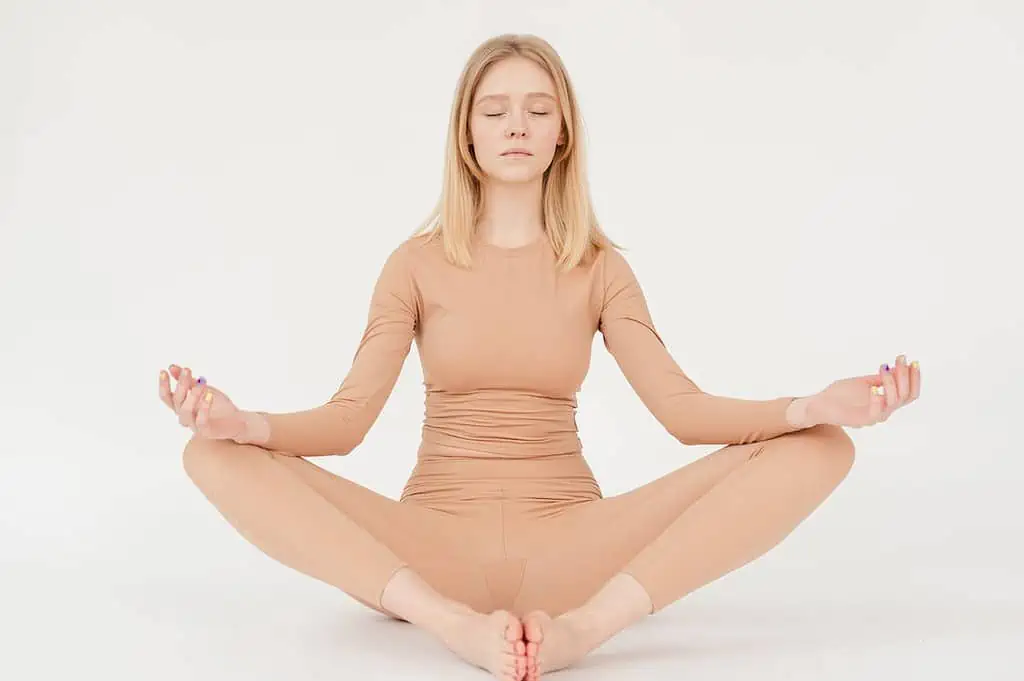
Forward Bend Pose (Paschimottanasana)
Paschimottanasana is another deep stretch that should also be included in a gentle yoga sequence as the more often you practice this yoga pose, the deeper your practice will become.
Extend both of your legs straight out in front of you, and keep your feet flat with your toes pointed toward the sky. If you need to release the tension in the backs of your legs, take a soft bend in your knees. You can also take a variation with your knees bent and a bolster or folded blanket placed underneath them for extra support.
In this extended-leg-straight position, you may feel enough of a stretch while sitting upright on your sit bones, or you may opt to fold and find a forward bend from the hips. If you can reach, gently pull the soles of your feet back toward you to keep them flexed. Here you may feel the intensity of the stretch and you may even notice that the left leg feels different from the right leg. Become curious about your body and flexibility as you breathe and stretch.
Ensure that your neck and shoulders are soft to avoid any neck pain. This pose is designed to help with back pain relief and to lengthen the muscles that run alongside your spine.
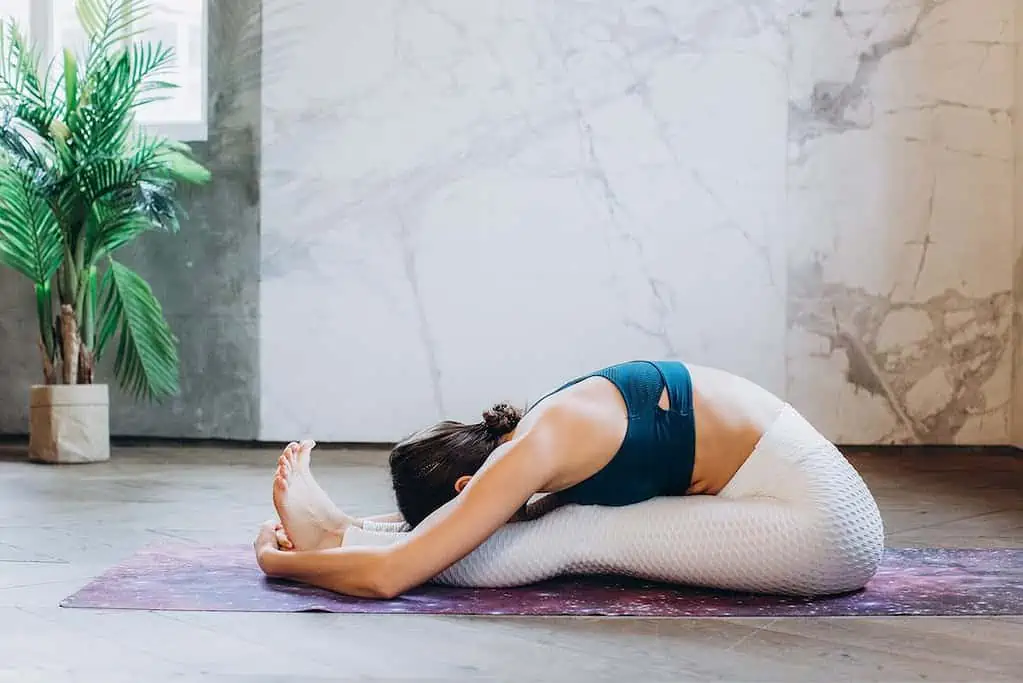
Half Lord of the Fishes Pose (Ardha Matsyendrasana)
For a twist in your gentle yoga sequence, add in the half lord of the fishes pose. This pose squeezes your insides giving you all the benefits of a yoga twist! It will open your upper body and stretch deeply through the left and right shoulder blades. Some variations can bump this twist up to the advanced poses category, but to make it gentle, stretch one leg out long as you gently press your hips into the ground. Pull your front knee in and use it to twist your body. Bring the spine back to a neutral position before twisting in the opposite direction. Ensure that you swap the front leg before twisting to the other side.
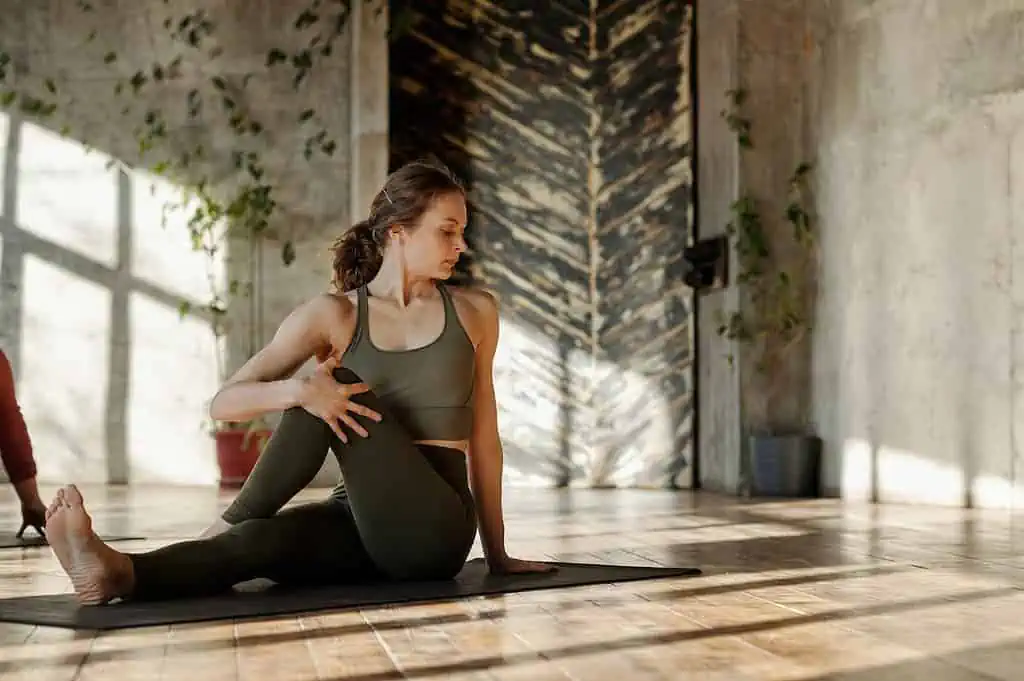
Corpse Pose (Savasana)
To end your gentle yoga journey, allow yourself to rest for a few minutes in corpse pose (savasana). This is an essential pose for any yoga class, whether it’s a hot yoga, power yoga session, or even yin yoga, The corpse pose is the ultimate finish. It gives your body time to relax, unwind, and integrate the energy of your practice into every cell in your body.
Lay down on your mat and relax your body. Feel the difference between your left leg and right leg, consciously letting go of any tension you are holding onto here. Soften through your left arm and right arm and melt your body into the ground. This is a good time to move through a body scan of the muscles from head to toe. Relaxing the muscles of the right and left thigh, softening the toes in the left foot and right foot. Let go of any muscles that are active in your belly, and soften your eyelids, mouth, and back of the head. Every part of your body can become heavy and melt deeply into the earth beneath you. Let go.
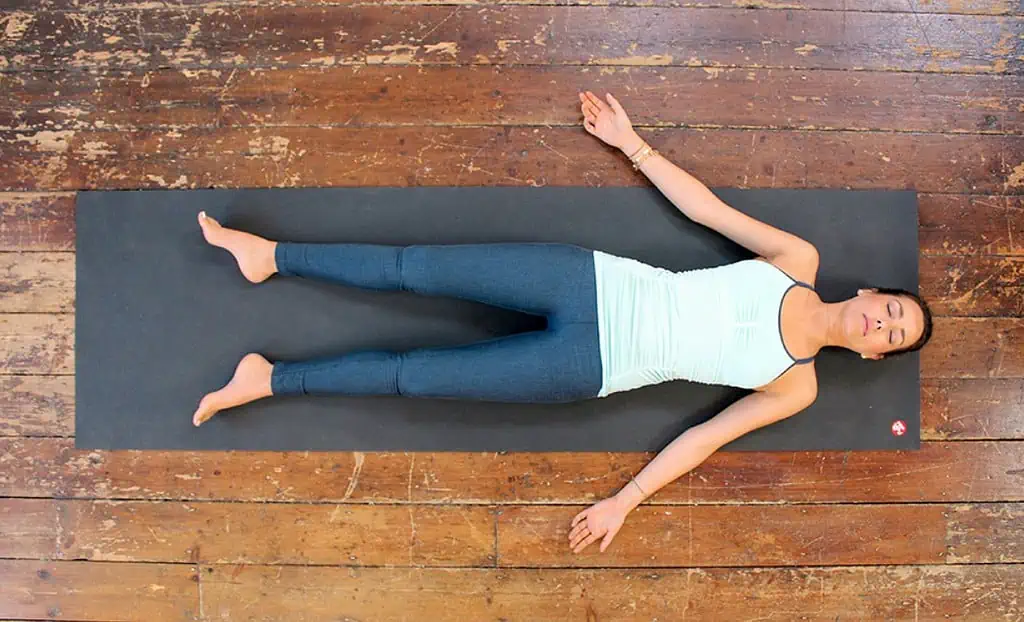
Finish with a short meditation practice
After you have enjoyed some time in your savasana pose, gently push yourself up to a seated meditation position. This can be any position that feels comfortable for your body. You may even like to sit on a yoga block to prop your hips up off the floor.
Close your eyes, rest your right and left hip evenly on the floor beneath you, and bring your awareness back to your favorite choice of breathing techniques. Take at least 10 to 20 deep breaths as you work on quietening your mind. Follow the flow of your belly button rising and falling with each breath.
Ending a yoga class with a short meditation seals your intention in your whole body. Use this time to send the peace and gentleness that you just cultivated into every cell in your body.
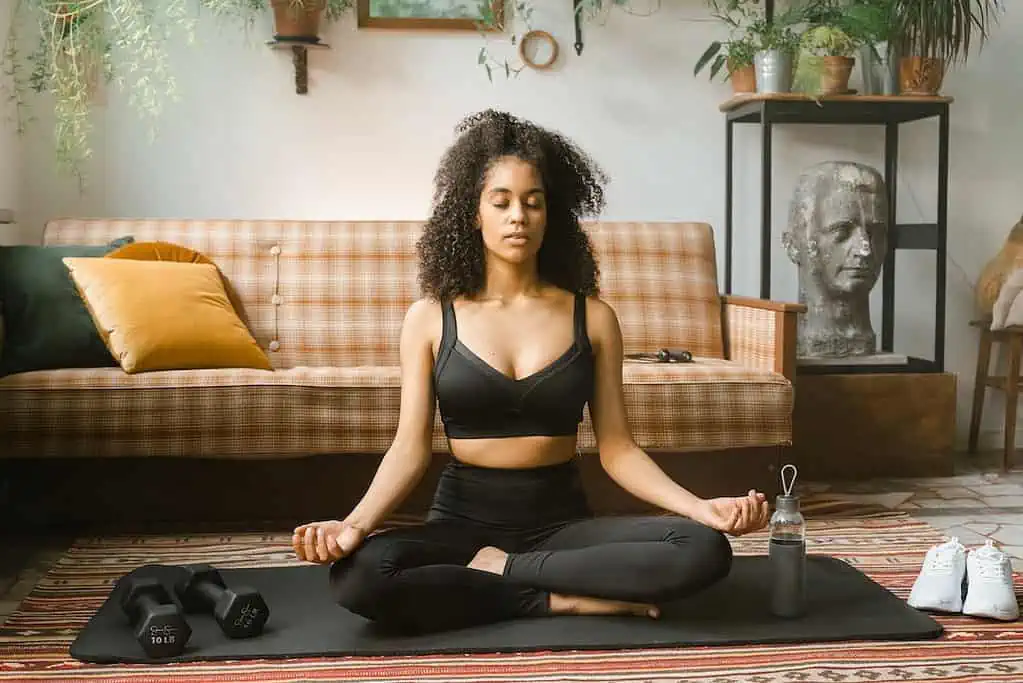
Putting it all together
Your gentle yoga routine may look a little different every day. You can mix up the poses, rearrange the order of your sequence, and even play around with adding new variations to stretch out different parts of your body.
For a holistic experience, add in your favorite yoga music, beautiful and calming scents, and all the props you need to ensure that you start to look forward to your weekly home yoga session!
Other creative gentle yoga classes
When you are ready to invite in a little more movement, you can try our Beginners Yoga Routine or an Energizing Morning Yoga Routine. You can also look online for a gentle yoga class run by a certified yoga instructor.
Frequently Asked Questions:
What is the most gentle yoga pose?
Savasana (corpse pose) is the favorite pose of most yogis due to its relaxing nature. Although it is physically gentle, it still has its challenges. The most difficult part of this pose is allowing the mind to be at peace too.
What are the benefits of a gentle yoga practice?
All yoga practices bring their benefits (from hot yoga to Iyengar yoga), but the beauty of a gentle practice is that it is extra calming on the nervous system and gives the body a chance to completely let go and relax.
Is gentle yoga practice only for beginners?
No, even the most advanced yogis should incorporate gentle yoga into their weekly routines to give the body a rest and allow time for body and mind rejuvenation.


